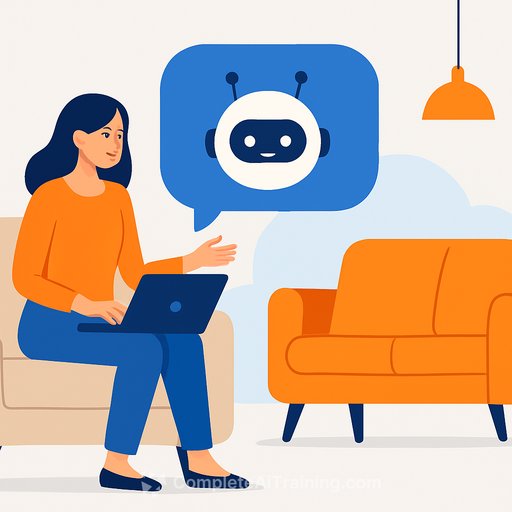Rufus in the Amazon app: what sales leaders need to know
Amazon's CEO Andy Jassy says Rufus, the in-app AI shopping assistant, is on track to add over $10 billion in annual sales. Since its August launch, 250 million shoppers have used it. Users who interact with Rufus are 60% more likely to complete a purchase. Monthly active users are up 140% year over year, and interactions are up 210%.
What Rufus is
Rufus is a chat-based assistant inside the Amazon Shopping app and desktop site. It helps buyers discover products, compare options, and get fast answers on product questions. It's trained on Amazon's catalog and web data, so answers are grounded in listings, specs, reviews, and public info.
Access is simple: update the Amazon app, tap the Rufus icon at the bottom (chat bubbles with a sparkle), or use it on desktop. Ask things like "what to look for when buying headphones?" or "which is better, OLED or LED TV?" It also suggests related searches to expand product discovery.
Why sales teams should care
Rufus changes how shoppers evaluate products: fewer clicks, more questions, faster comparisons. That means your content quality, structure, and clarity impact whether you surface in chat answers-then win the decision. With a 60% lift in completion for users, the upside is clear.
How it works (and how to win)
- Answer the actual questions. Add short, clear FAQ-style content to product pages that mirrors buyer queries (e.g., "Over-ear vs in-ear," "OLED vs LED," "Best headphones for calls").
- Make comparisons effortless. Standardize specs across SKUs: dimensions, materials, battery life, compatibility, warranty. Use consistent naming so Rufus can line up apples-to-apples.
- Write for intent, not just keywords. Include phrases buyers ask in plain language: "best for running," "under ₹5,000," "gift for dad," "small kitchens," "travel-friendly."
- Bullet benefits first. Lead with 3-5 crisp outcomes ("Blocks 90% ambient noise," "Pairs in 2 seconds," "Charges once a week"). Keep it skimmable.
- Mine reviews and Q&A. Pull the top objections and use them in bullets and FAQs. If buyers keep asking it, answer it up front.
- Structure A+ content. Use clean sections with headlines that map to common questions. Avoid filler.
- Create comparison-ready bundles. Gift sets and "complete kits" align with "ideas for…" and "what do I need for…" prompts.
- Refresh titles and attributes. Include core specs buyers ask about (screen type, RAM, size, material). Keep it accurate and consistent across variants.
- Fuel the engagement loop. Use retail media to drive traffic to optimized listings. More interactions = more signals for Rufus to surface you.
- Close the loop with feedback. Encourage shoppers to rate answers and submit feedback. Iterate content monthly based on what pops in Q&A and returns.
Playbook by role
- Sales leadership: Assign a Rufus owner. Set a weekly "question coverage" KPI across top 50 SKUs. Track conversion and add-to-cart changes for sessions with chat exposure.
- Content/brand team: Build a living bank of buyer questions per category and map each to a bullet, spec, or visual. Update with each launch and season.
- Performance marketers: Bid on intent phrases reflected in Rufus prompts. Test creative that mirrors chat language in headlines.
- Category managers: Standardize attribute taxonomy across the catalog so comparisons are clean. Remove redundant variants that confuse the model.
What buyers are asking (use this to shape content)
- "Which TV fits a 10x12 room?"
- "Best budget earbuds for calls?"
- "Gift ideas for new parents under ₹2,000."
- "OLED vs LED for sports."
- "What to look for in an office chair for back pain?"
Turn each into a bullet, a spec, or a short FAQ on your product page. The closer you match the question, the more likely you appear in chat answers.
Quick checklist
- Top 10 questions covered on every hero SKU.
- Specs normalized across variants and competitors you're compared against.
- Benefits-first bullets, no fluff, no jargon.
- Updated A+ content with scannable sections that mirror common prompts.
- Review/Q&A mining baked into your monthly content sprint.
- Retail media aligned to intent phrases surfaced by chat.
What Amazon confirmed
- Launched in August for India, available in the app and on desktop.
- Trained on Amazon's catalog plus web data for relevant responses.
- Shoppers who use it are 60% more likely to finish a purchase.
- 250 million users to date, with strong growth in monthly actives and interactions.
- Feature is improving; Amazon is collecting feedback to refine answers.
Upskill your team for AI-driven marketplace selling
If you're building a sales org that competes inside AI-assisted shopping, train the team on prompt-like messaging, structured content, and intent mapping. Practical courses by role can help speed this up.
Your membership also unlocks:






